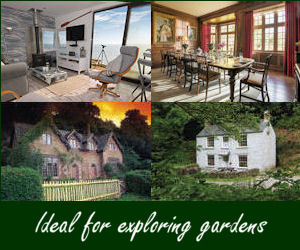Lanhydrock
| Contact | Rebecca Brookes-Sullivan |
| Enquiries | 01208 265950 |
| Fax | 01208 265959 |
| lanhydrock@nationaltrust.org.uk | |
| Website | www.nationaltrust.org.uk/lanhydrock |
| 30 acre formal / informal / woodland garden laid out since 1857. Exceptional magnolias both mature and young. Large numbers hardy rhododendrons. Many rare trees and shrubs. Unique circular herbaceous garden. | |
| Open | Gardens open daily all year round 10:00 - 18:00. House open 13th Mar - 31st October, Tuesday - Sunday 11.00 - 17.30 (17.00 October) Also open on Bank Holiday Mondays and Mondays during the school holidays. |
| Admission | House, Park and Gardens Adults: £10.90, Child £5.40 Garden & Grounds £6.40 Child £3.45 |
The Lanhydrock Estate belonged to the Augustinian priory of St Petroc at Bodmin established in the 6th century. During the Reformation the church's control ceased when the ownership of their lands was transferred to the Crown. In 1538 Bodmin Priory was dissolved and sold by the King to his contractor Thomas Sternhold who divided the lands and in turn sold them on, Padstow Grange and its lands including Prideaux were sold to the Nicholas Prideaux Esq. and the barton at Lanhydrock sold to the neighbouring Glynn family.
The estate passed by marriage to the Lyttelton family and again through marriage, to Thomas Trenance in 1577. Lyttelton Trenance - the son of Thomas Trenance - sold the estate to Sir Richard Robartes. Sir Richard Robartes who was knighted in 1616 rose in affluence from his family's interests in the tin trade and as merchants and bankers. And he was able to buy the Lanhydrock Estate in 1620.
In 1624, James I granted Sir Richard a peerage Lord Robartes of Truro. Six years later, in 1630, Lord Robartes began the construction of a traditional four sided Tudor mansion around a central courtyard, replacing the Barton that had been occupied by the Trenance family. Lord Richard Robartes died in 1634 and it was his son John, 2nd Lord Robartes who was left to complete the building programme which included the Gatehouse which was constructed in 1641. Lord John Robartes was created Viscount Bodmin and 1st Earl of Radnor in 1679. He died at his house in Chelsea in 1685 and his body was taken back to Lanhydrock for burial, in his native Cornwall.
In 1697 Charles Bodville Robartes' (the 2nd Earl of Radnor) commissioned a survey of the Cornish Estates detailing the then 40,000 acres on 258 manuscript maps. These four volumes still remain at Lanhydrock today.
With the exception of the demolition of the east range about 1780 by George Hunt, little change was made to the house over the next two centuries, and the house gradually lapsed into a state of disrepair. Thomas James Agar-Robartes, assumed the name Robartes in 1822. He lived permanently in the house from the time of his marriage in 1839 to Juliana Pole Carew Daughter of the Hon. Reginald Pole Carew of East Anthony. In 1857 he commissioned George Gilbert Scott to modernise and remodel Lanhydrock House to a comfortable country house, taking over full running of the estate after inheriting it from his mother in 1861.
Thomas was created Lord Robartes of Lanhydrock and Truro in 1869.
On the 4th April 1881, a disastrous fire destroyed the house, leaving only the north wing, the entrance porch and gatehouse. The shock of this disaster killed Lady Robartes a few days later. Distraught at losing both his wife and his home, Lord Robartes died the following year. Their son, Thomas Charles Robartes succeeded as the 2nd Lord Robartes (later the 6th Viscount Clifden) and he began the reconstruction of Lanhydrock. He had the house re-built with a neo-Jacobean facade, but used a traditional Victorian arrangement for rooms internally.
This work was undertaken by a local architect, Richard Coad, a former pupil of George Gilbert Scott's and who had previous experience of Lanhydrock during the earlier modernisation programme. A whole new complex adjoining the existing southern range of the house was also added. The works undertaken took just over 4 years and upon their completion Lord Robartes restored the adjacent St. Hydrock Church in memory of his parents.
In 1953, the house and approximately 400 acres of parkland were given to the National Trust by the 7th Viscount Clifden. The public tour of 50 rooms is one of the longest at any National Trust house, and takes in the state rooms, reception rooms, children's nursery and family bedrooms, as well as the kitchens, larders and sculleries, and some servants' bedrooms.
There is a restaurant and shop in the house and plant sales in the car-park.
The 31 acres gardens at Lanhydrock which were started in 1857 contain one of the best formal gardens in Cornwall and still maintain the 19th century plan with clipped yews, box parterres and bedding out, as well as large herbaceous borders. The parterres have bronze urns brought from the Chateau de Bagatelle in Paris and taken to Lanhydrock when the gardens were laid out in 1857.
A famous avenue of beech and sycamore trees the original entrance drive to the house runs from the gatehouse down towards the medieval bridge across the Fowey at Respryn.
The higher gardens are set on a hillside above the House and the Park contain some exceptional trees many dating from 1634. There are also fine collection of magnolias, rhododendrons and camellias set against a backdrop of indigenous oak and beech woods. The magnolias are particularly impressive with 140 different species and cultivars.
The estate extends to around 900 acres and has a network of footpaths and estate walks though the parkland, bluebell carpeted woodlands and meadows.



